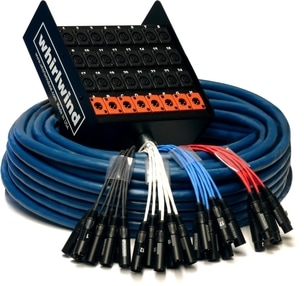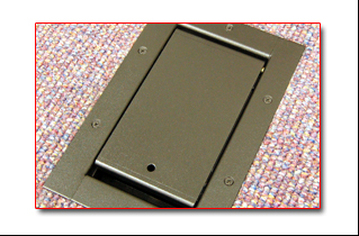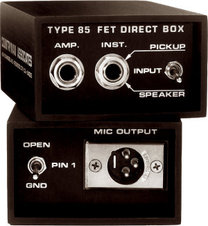BUYING GUIDE - CABLES & INTERCONNECTS
 Neutrik connectors are the way to go
Neutrik connectors are the way to go
The best brand in my opinion for cables and audio snakes is Whirlwind. I toured with a worship band for about 7 years with thousands of miles of travel, and the one brand of cable I never had to repair or replace was Whirlwind. They by far make the best cables and snakes out there. I still have Whirlwind cables purchased 15 years ago still in service today. They are a little bit more money up front, but the investment was well worth it. I would have gone through 10 other cables in place of that one, and spent way more had I not just bought Whirlwind to begin with. A close second for me would have to be ProCo. They make some decent gear as well.
The reason why whirlwind makes some of the best XLR (mic cable), and 1/4" cables is because of the type of connector they have chosen. As you can see in picture below, the connector they use features a "chuck" type system that features 3 sets of teeth that clamp down onto the outer jacket of the cable, and then locks into place when the connector is put together. The outer bushing, then screws directly onto the housing, and as it gets tighter, it tightens the chuck's teeth onto the cable..

On a cheaper connector, the only thing that is holding the cable into the plug housing, is a thin & sharp piece of metal that just clamps onto the outer jacket of the cable Also with the better connector above, there is a thick piece of plastic that separates the + and - connections of the connector, whereas in this one, there is nothing separating the two. Most of the time this is where failure occurs in these cheaper connectors; because very rarely do manufacturers pre-tin the copper strands of cable, and over time the connection will short out.
What should you get in an audio snake?
You always want to allow yourself room to grow. If you are only going to run 8 channels of audio, it's wisdom to purchase a 16 channel snake. If you currently need 4 returns, it is wisdom to purchase a snake with 8 instead. Make sure you keep in mind the type of connections on both sides of the stage. If your mixing console and/or EQ's have XLR outs, then make sure your snake has the same type of connectors. On the other side of the stage, if your amplifiers only have XLR inputs, then you'll need to make sure your snake interfaces correctly. You may be going into a crossover before an amp, or some other outboard gear...you really have to think this out before blindly purchasing a snake configured the wrong way.
And as always, if you really are unsure as to what you need, please feel free to post a question in our Member's Forum. Be sure to include all of the particulars!
You always want to allow yourself room to grow. If you are only going to run 8 channels of audio, it's wisdom to purchase a 16 channel snake. If you currently need 4 returns, it is wisdom to purchase a snake with 8 instead. Make sure you keep in mind the type of connections on both sides of the stage. If your mixing console and/or EQ's have XLR outs, then make sure your snake has the same type of connectors. On the other side of the stage, if your amplifiers only have XLR inputs, then you'll need to make sure your snake interfaces correctly. You may be going into a crossover before an amp, or some other outboard gear...you really have to think this out before blindly purchasing a snake configured the wrong way.
And as always, if you really are unsure as to what you need, please feel free to post a question in our Member's Forum. Be sure to include all of the particulars!
If you are in the market for an audio snake, I would recommend the Whirlwind Medusa series:
If you are on a tighter budget, their connect series is a good alternative:
Stage Pockets (Where form & function meet)
A stage pocket is a pre-configured metal box with a lid mounted in the floor of the stage which can house microphone, instrument, power, and monitoring system connections. So, instead of all of the instruments going to a central snake input box, they would go to their respective stage pockets according to position on the stage. Then from there, it is common to run each set of outputs from each stage pocket, to a central snake (this way channels can be moved and reconfigured quickly on the main snake to the mixing console. This is incredibly useful for any future changes that may come your way.
A stage pocket can look like this:
A stage pocket is a pre-configured metal box with a lid mounted in the floor of the stage which can house microphone, instrument, power, and monitoring system connections. So, instead of all of the instruments going to a central snake input box, they would go to their respective stage pockets according to position on the stage. Then from there, it is common to run each set of outputs from each stage pocket, to a central snake (this way channels can be moved and reconfigured quickly on the main snake to the mixing console. This is incredibly useful for any future changes that may come your way.
A stage pocket can look like this:
|
Ace Backstage makes the best stage pockets I have seen. I cannot express enough though, that a lot of planning needs to go into what types of connectors each box should contain, and where you want the actual stage pockets to be located. Holes have to be cut into the stage to accommodate each pocket, so you really don't want to make any mistakes if you decide to go that route. They come in a variety of configurations that you can custom build and terminate yourself. One of the reasons that I really like the Ace Backstage stuff is because the build quality of the box itself is excellent, and the way the lid is engineered. As you can see to the left, there is a gap that runs the length of the lid. This allows the cables to not be pinched, and to "flow" and go where ever they need to. This is a big, time saver compared to a box like this below:
The reason is because every time you have to plug in a cable or take a cable out, you have to gather all the cables and make sure they fit in the holes while you are closing the lid. This is a waste of time and a real pain, and especially when you are pressed for time right before a service. Also, what happens if your cables that are bunched together are bigger than the hole that is allowed for them to fit through? That means you just have to leave the lid open, thus creating a tripping hazard and stage clutter!
|
 The IMP 2 - Best D.I. for the budget conscious!
The IMP 2 - Best D.I. for the budget conscious!
Direct Boxes (Interfacing between instruments and mixing consoles)
In a nutshell, a direct box converts a signal from a musical instrument to a signal that is useable for the mixing console. Acoustic guitars, bass guitars, and keyboards are the most common instruments that use a direct box.
Radial, Countryman, and Whirlwind all make excellent direct boxes. Keep in mind that super cheap direct boxes can have a very limited frequency range (i.e. your instrument could sound terrible). If you must buy a cheap direct box, get a Whirlwind IMP 2. Best bang for the buck! If you really want a top quality direct box, I would choose Radial or Countryman, although Whirlwind makes some really nice upper end direct boxes as well.
In a nutshell, a direct box converts a signal from a musical instrument to a signal that is useable for the mixing console. Acoustic guitars, bass guitars, and keyboards are the most common instruments that use a direct box.
Radial, Countryman, and Whirlwind all make excellent direct boxes. Keep in mind that super cheap direct boxes can have a very limited frequency range (i.e. your instrument could sound terrible). If you must buy a cheap direct box, get a Whirlwind IMP 2. Best bang for the buck! If you really want a top quality direct box, I would choose Radial or Countryman, although Whirlwind makes some really nice upper end direct boxes as well.
There are specialty direct boxes used for instruments such as acoustic guitar and bass. For acoustic, my favorite direct box is the Fishman Platinum Pro D.I.. Another favorite choice of musicians is the L.R. Baggs Para Acoustic D.I. L.R. Baggs also makes an acoustic direct box called The Venue (but she's not cheap). I know that Roland, Yamaha, and K&K make decent boxes as well. The best thing to do is to try them all out and see what fits your needs and sounds the best.
There are some really great choices for Bass guitar as well out there (although in your particular case, it may not be needed. A lot of bass guitar amp manufacturers are building XLR direct outs on their bass amps nowadays. Before you go lay down a lot of money for a fancy D.I., check to see if the bass amplifier you are playing out of, already has a direct to house function built into the back (or front) of the amp.
Now, if a church is concerned about stage volume from a bass amp, it could purchase a SansAmp Bass Driver D.I. (very popular box), or the fancier SansAmp RBI. Both are great for what they do. There are more expensive units out there, like the Avalon Ultra 5, but it is quite a bit more and doesn't offer the same flexibility as the SansAmp units.
**Just So You Know - I am not in any way affiliated with any companies mentioned. My selections on what the best gear is, is from direct personal experience with said items. I have nothing to gain by recommending any piece of gear, other than the piece of mind knowing you'll be getting reliable stuff that works.
|
|












